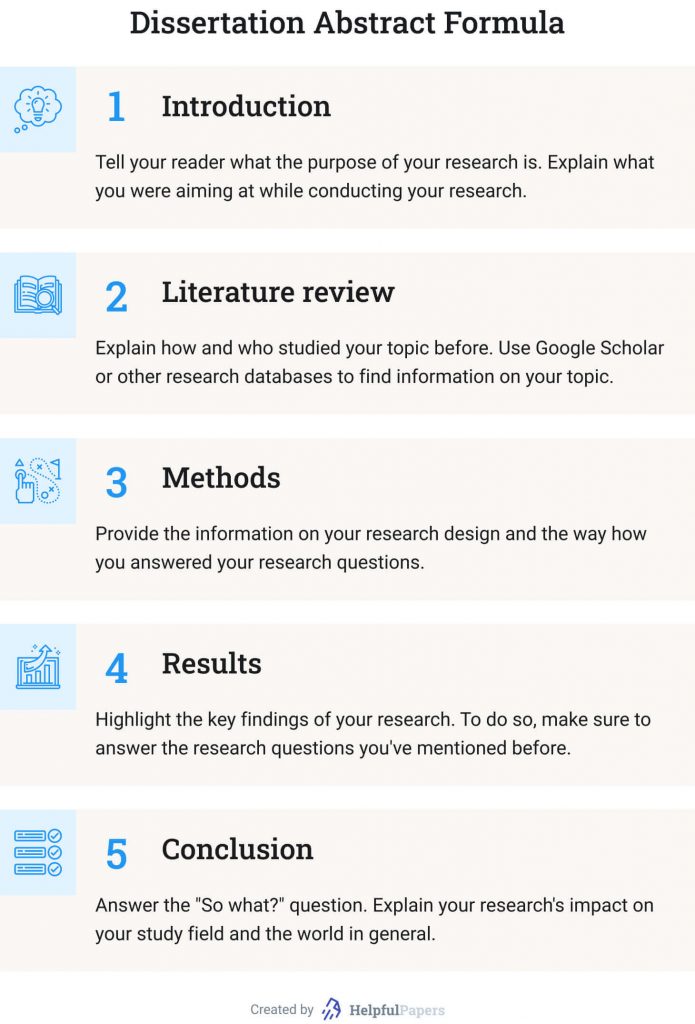👨🎓️ What Is a Dissertation Abstract?
A dissertation abstract is the summary of your research that encapsulates the work’s key points and shines the light on its significance. Typically, it spans about one or two pages (300 to 500 words). The author is expected to showcase the importance of their project and briefly present the findings.

One might think that a dissertation abstract is just a fancy term for the executive summary. Well, this is not the case. Let’s take a closer look at the differences between these two forms of project synopsis.
Dissertation Abstract vs. Executive Summary
Both dissertation abstract and executive summary convey the crux of your thesis. However, they cope with the challenge using varying degrees of detail.
Dissertation abstract
- Highlights the core aspects of the research.
- Unpacks its overall importance.
- Provides a brief snapshot of the thesis.
Executive summary
- Highlights the core aspects of the research.
- Unpacks its overall importance.
- Provides a compact yet comprehensive account of research.
In the upcoming sections, we will provide an in-depth, step-by-step guide on how to write a dissertation abstract. By the way, if you need to make a summary of your research project before crafting the abstract, feel free to check out our free summarizing tool.
🎯 What Are the Purposes of a Dissertation Abstract?
The first purpose is to give your reader a snapshot of what your dissertation is about before making them read the entire piece.
In other words:
The dissertation abstract must promptly explain the following:
- What your project is about
- What the key findings are
- Why these findings matter
After skimming through your abstract, the reader will be able to decide if your thesis is relevant and worth reading or not.
Another purpose of your dissertation abstract is to let dissertation databases and search engines know about your work because they index and categorize it. Using your abstract’s keywords will make it easy for users to discover it.
🔢 Dissertation Abstract Formula
If you are wondering how to write a dissertation abstract, here’s a formula for you. Every well-written abstract adheres to the following template:
- Introduction
- Literature review
- Methodology
- Results
- Conclusion

Let’s look closely at each of the parts!
Introduction
This section gives your reader a sense of what’s at stake and why it matters.
You should clarify:
- What you were aiming for with your research;
- What burning questions you posed;
- In what way these questions are relevant to the research field.
The introductory part is to be convincing, straightforward, and concise.
Remember:
The overall purpose of your abstract is to grab your reader’s attention, and the introduction is your golden opportunity to make it happen.
Here are the phrases you can use:
- The research examines…
- The report sheds light on…
- The study investigates…
Literature Review
The literature review should explain how and who studied your topic before. You can check out Google Scholar or other research databases to find information on your topic.
Some of the phrases that you may use here are the following:
- Many previous studies agree that…
- To contrast the traditional views on this question…
- There’s a noticeable gap in the literature regarding…
Methodology
In this part, you should elaborate on the exact methods you used in your research. Provide information on your research design and the ways you answered your research questions.
You should let your reader know:
- What overall approach you used (quantitative or qualitative);
- What or who your sample consists of;
- What tactics you used to collect and analyze your data.
Results
Here you should let your reader what know the findings of your research are. You don’t need to explain everything in detail, just spotlight the most impressive findings. To do so, make sure to answer the research questions you’ve mentioned before.
Remember to keep this part brief and clear, too.
Some of the phrases you can use here are the following:
- The results of this study identified…
- The analysis has shown that…
Conclusion
The conclusion is where you should tackle the “So what?” question. Whether you are studying law, engineering, nursing, history, a humanities major, or any other, you should let your reader know what your findings mean in a bigger picture.
Explain your research’s impact on your study field and the world in general. Make sure to mention if your findings reinforce existing research and impact future research.
Some of the phrases that you may use here are:
- Further research is necessary to…
- These findings might be used in practice…

📝 Dissertation Abstract Examples: Bad & Better
We have learned the theory, so let’s see how we can use it. Here some dissertation abstract examples for you – both flawed and stellar.
Let’s take a look at the less effective example first.
A Bad Dissertation Abstract Example
In this paper on "Class Size: Does It Matter?", I conducted research on how the size of a class affects academic performance Students in a class with fewer people are more engaged in in-class discussions and show better results than those in a class with more people. The project is a comparative case study. It can improve academic performance.
What’s so wrong with the abstract above?
- There is no literature review. No mention of previous research or knowledge gaps. The author didn’t state anything about the previous research on the topic.
- The research methods are murky. The readers are left guessing how exactly the size of a class affects academic performance.
- There is no information about the impact of the research. The author does not explain how exactly its results will help to improve academic performance.
And now, let’s look at a better example with explanation.
A Good Dissertation Abstract Example
What can be done to improve academic performance? There are studies that show that smaller class size allows uncovering students' potential more efficiently by giving them more chances to be engaged in in-class activities. However, they differ in their methods and demonstrate somehow mixed effects, which makes further research necessary. To conduct a comparative case study, I examine two different senior high school classes in New Jersey. The participants of the study were students of similar socioeconomic backgrounds. Class A has 28 students, while class B has 16. The dissertation focuses on differences in the educational outcomes and in-class learning opportunities of students of both classes. The analysis showed that class B students were more engaged in in-class discussions and received a 78.5 average final score. Class A's students were less engaged in in-class activities and received a 72.5 average final score. These findings might be used in practice to improve academic performance in high schools.
After reading the piece above, we have a much better understanding of the topic. So, what makes this abstract stand out?
- The research problem is stated clearly. Despite the introduction’s brevity, the research question is well-articulated, and the significance is shown.
- There is a literature review. The existing research on the topic is briefly showcased, and gap in the knowledge is demonstrated.
- The research methods are transparent. There is just enough information about the methodology and the participants of the study.
- The key findings are clear and precise. The results are comprehensible and easy to understand.
- The research has significance. The author stated how the findings could be used in the future.
Let us know your tips for writing a dissertation abstract in the comments below!
❓ Dissertation Abstract FAQ
What is a dissertation abstract?
A dissertation abstract is like a trailer for your dissertation. It should spotlight the big ideas of your work, lay out your methodology, and showcase the findings to convince your reader to read your work. Try to make it concise – one page is usually enough.
How to write a dissertation abstract?
Crafting a standout dissertation abstract involves hitting the main ideas of your research, explaining your methodology, and listing your findings. Try to keep your abstract tight, factual, and grammatically flawless. Your sentences should be short and to the point, and your research should be explained well.
How long should a dissertation abstract be?
A dissertation abstract is usually about one page or 300-500 words long. However, each university might have its own standards. Remember to include all the necessary details in your abstract. Try to cover the main ideas, purpose, and methodology.
What is included in the dissertation abstract?
A dissertation abstract should include information about the main idea of your dissertation. You should also explain your methodology and the findings. Try to cover the purpose of your research to let your reader know the meaning behind your work.